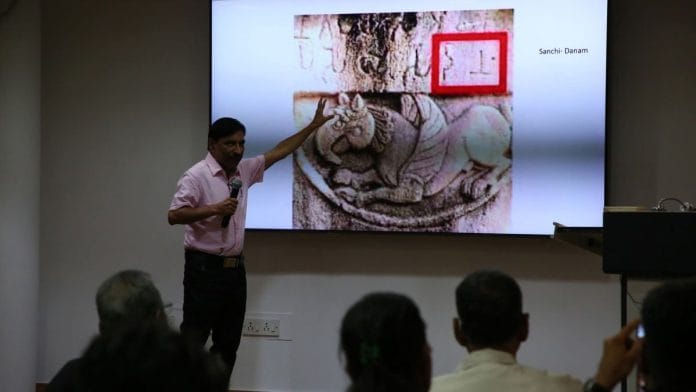New Delhi: When veteran archaeologist KK Muhammed was on a hunt for Akbar’s Ibadat Khana in Fatehpur Sikri, a 500-year-old Mughal painting came to his rescue. A piece of art became a tool for looking into the past.
“For centuries, historians were divided on where Akbar’s Ibadat Khana existed, the place he had invited people from all religions to,” Muhammed said at Delhi’s Indian National Trust for Art and Cultural Heritage (INTACH).
Muhammed has served as Regional Director (North) at the Archaeological Survey of India (ASI). In the early 1980s, he was a student at the Aligarh Muslim University and explored Fatehpur Sikri under his professor, RC Gaur. During his research, he encountered a painting from Akbar’s time, which was in the Chester Beatty collection. The collection holds many Indian miniatures, including 16th-18th century Indian art from the Mughal, Deccani, and Rajput eras.
“I had seen the painting, and then I looked at the site. The arches are there, like it is in the painting. It was on the basis of the Mughal painting that the Ibadat Khana was identified [in Fatehpur Sikri],” he recalled, sitting in a room full of history enthusiasts.
In an hour-long lecture titled ‘Stories from Indian Archaeology’, Muhammed recounted fascinating stories of archaeology and behind-the-scenes anecdotes from his excavation days. He is credited with the discovery of Akbar’s Ibadat Khana, prominent Buddhist stupas, and with the restoration of the Bateshwar temple complex by convincing dacoits of the Chambal.
After Ibadat Khana, Muhammed was on a quest to find the Christian Chapel made by Akbar. Again, a Jehangir-era painting helped him locate it in the Mughal emperor’s first capital, Fatehpur Sikri. Muhammed said that the place it was built was Khusbu Khana (perfume room), which was emptied and converted into a chapel.
An excavation trench on the mound was laid, and Muhammed’s team found three rooms there. However, the chapel used to be a Khusbu Khana, so finding the setup for making perfumes was a must.
The discovery of a kadahi (wok) and a perfume bottle would establish the link. “The bottle looked the same as a painting of Jehangir’s time,” said Muhammed. Based on the Mughal painting and excavations, his team could prove that it was Akbar’s Christian chapel.
Muhammed added that Christians during Akbar’s time were hoping that the Mughal emperor would accept their religion. And because of Akbar’s tolerance for various religions, Muslims were upset.
Muhammed added that Akbar wanted to bring all the communities into one single harmonious home.
“He wanted Muslims to know about Hindu mythology,” he said, adding that during his reign, Ramayana and Mahabharata were translated.
In 1574, Akbar started a Maktab Khana (House of Translation) at Fatehpur Sikri and assigned a group of scholars to translate texts into Persian, the literary language of the Mughal court.
Muhammed summed up Akbar’s personality with Akbar Allahabadi’s couplet:
“zahid-e-tang-nazar ne mujhe kafir jaana,
aur kafir ye samajhta hai musalman hoon main…
(The narrow-minded devotee considers me an infidel,
and the infidel thinks I am a Muslim…)”
Also read: Greek hero in Kolhapur, Indian statue in Pompeii—how art, trade, beliefs transcended borders
Buddhist history nearly lost
After the death of the Buddha, his mortal remains were distributed among eight places. Some of the places were excavated by the British in the 19th century, including Sarnath, Vaishali, and Piprahawa. Recently, the Indian government brought back the Piprawaha relics from Hong Kong.
Magadha, by virtue of being the most powerful kingdom of the day, got the largest share of the Buddha’s mortal remains. But no one knows where exactly they were buried.
Muhammed told the attendees an interesting episode on how a piece of history was nearly lost because of a railway project. Nitish Kumar, then railways minister, wanted to have a line connecting Bihar’s Rajgir to Patna. And that line was supposed to pass through the ASI heritage zone.
When the railways reached out to Muhammed, who was posted there between 1997-2001, he declined permission. “Because that was a hefty land. Although it was not a protected area, there are so many remains there,” he said.
Without wasting any time, Muhammed started a salvage excavation on the land. “I knew that I was going to get something great,” he said, adding that if he had waited for ASI permission, it would have taken time, and the railway work would have started.
The excavators discovered a part of the relic casket that contained the Buddha’s remains. Muhammed said that centuries ago, treasure hunters had removed the relics from the casket.
“The treasure hunters could get only a few bones and pieces. They could not realise the importance of these remains and just threw them out,” he said. If Muhammed had found the full relic casket, he would have gotten his most important discovery.
“Still, it is very important for history,” he said.
From the tales of the Buddha’s remains in Bihar, Muhammed took the audience to the Buddhist Stupa in Sarnath. When archaeologist Alexander Cunningham excavated Sarnath in 1835-36, he did not know the structure was a Buddhist stupa. He was intrigued by the dome structure and thought it was a Jain complex.
Cunningham studied travel records by ancient Chinese travellers, such as Faxian and Xuanzang, which had been translated into English in the 19th century. These, in combination with the stone slab inscriptions at Sarnath, revealed the Buddhist past of the site.
Muhammed said that Nalanda had been explored by archaeologists in 1811, but no one knew it was the Nalanda University. It was only in 1856 that Cunningham came to know about the fact, based on Xuanzang’s descriptions.
(Edited by Prasanna Bachchhav)






